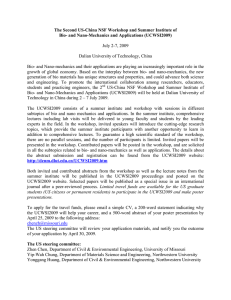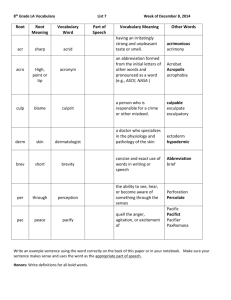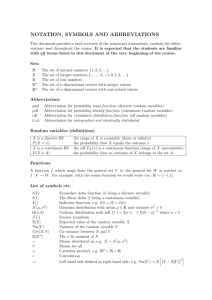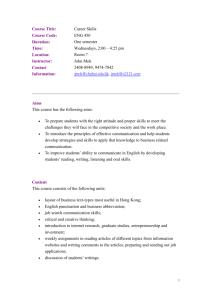File
advertisement
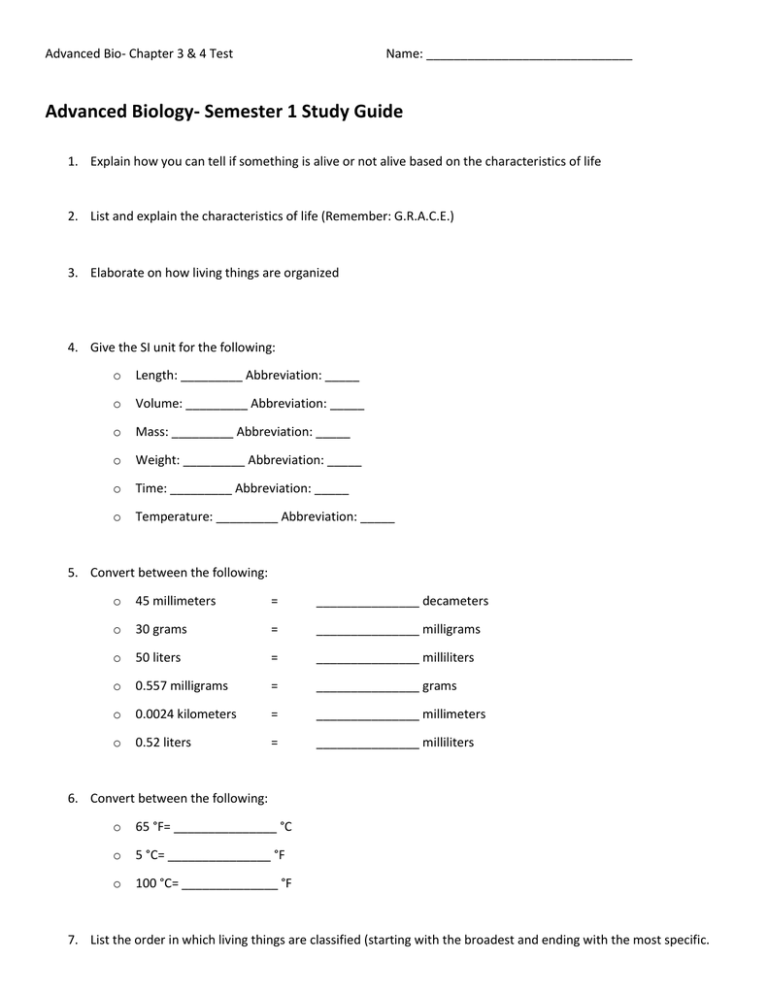
Advanced Bio- Chapter 3 & 4 Test Name: ______________________________ Advanced Biology- Semester 1 Study Guide 1. Explain how you can tell if something is alive or not alive based on the characteristics of life 2. List and explain the characteristics of life (Remember: G.R.A.C.E.) 3. Elaborate on how living things are organized 4. Give the SI unit for the following: o Length: _________ Abbreviation: _____ o Volume: _________ Abbreviation: _____ o Mass: _________ Abbreviation: _____ o Weight: _________ Abbreviation: _____ o Time: _________ Abbreviation: _____ o Temperature: _________ Abbreviation: _____ 5. Convert between the following: o 45 millimeters = _______________ decameters o 30 grams = _______________ milligrams o 50 liters = _______________ milliliters o 0.557 milligrams = _______________ grams o 0.0024 kilometers = _______________ millimeters o 0.52 liters = _______________ milliliters 6. Convert between the following: o 65 °F= _______________ °C o 5 °C= _______________ °F o 100 °C= ______________ °F 7. List the order in which living things are classified (starting with the broadest and ending with the most specific. Advanced Bio- Chapter 3 & 4 Test Name: ______________________________ D____________ ____________ ____________ ___________ ____________ ___________ ___________ S_____________ 8. List the 4 different KINGDOMS, describe them, AND give an example of each. ( 9. Use the scenario below to answer the next 4 questions. You want to see which type of mouthwash is the most effective at killing bacteria that live in the mouths of humans. To test this, you set up an experiment where you choose 4 different mouth washes and add 3 drops of each to different petri dishes containing cultures of bacteria found in the human mouth. o What is the independent variable in your experiment? o What is the dependent variable? o What might be a good control? o List 3 things that would you need to keep constant in order to have accurate results. Advanced Bio- Chapter 3 & 4 Test Match the microscope to the right with the parts listed below. 10. ____ Stage clips 11. ____ Light source Name: ______________________________ A B F 12. ____ Fine adjustment 13. ____ Coarse adjustment G 14. ____ Base 15. ____ Stage 16. ____ Diaphragm C H 17. ____ Neck 18. ____ Objective(s) D I 19. ____ Rotating nose piece E J 20. The microscope above has 3 objectives: the scanning objective= 10x, the low power objective= 43x, and the high power objective= 100x. Find the total magnification for all three objectives. (2 pts) 21. List 3 rules for handling a microscope correctly. 22. Define matter and elements. 23. Which 6 elements make up about 95% of the body weight of life? Advanced Bio- Chapter 3 & 4 Test 24. Compare atomic mass and atomic number. Name: ______________________________ 25. What makes an isotope radioactive and why are high levels of radiation harmful? 26. Compare and contrast covalent and ionic bonds and covalent and ionic compounds. 27. Compare the terms hydrophobic and hydrophilic. 28. Compare different properties of acids and bases. 29. Compare organic and inorganic substances. What are some examples of each? 30. Compare monomers and polymers. 31. List the 4 types of macromolecules AND their corresponding monomer. 32. Describe the processes of dehydrate and hydrolysis and their importance. 33. List the importance of carbohydrates. Advanced Bio- Chapter 3 & 4 Test Name: ______________________________ 34. Compare monosaccharaides, disaccharides, and polysaccharides. Be able to give an example for each. 35. List the importance for lipids. 36. List the 4 types of lipids. 37. Describe the process of emulsification. 38. What are some common steroids in your body? 39. List the importance of proteins. 40. Why is the ‘R group’ important on a protein molecule? 41. List 4 examples of proteins in your body. What is the importance of an enzyme? 42. Compare DNA and RNA. 43. Explain the importance of nucleic acids. 44. What makes up a nucleic acid? Advanced Bio- Chapter 3 & 4 Test Insert old matching ?s Name: ______________________________ Advanced Bio- Chapter 3 & 4 Test Name: ______________________________ Matching/Interpretation (2 pts each 45. Hypertonic solution 46. Hypotonic solution 47. Isotonic solution A B Match the scientist below with their discovery/experiment in the field of microbiology: 48. Virchow 49. Hooke 50. Leeuwenhoek 51. Schwann 52. Schleiden A. B. C. D. E. Discovered first living cells in pond water Discovered that all cells come from other living cells All animal cells are made of cells All plant cells are made of cells Discovered first dead cells in cork C Advanced Biology Honors- Chapter 3 & 4 Test Label the following: 53. 54. 55. 56. 57. 58. Cytoplasm Flagellum Capsule Cell wall Ribosomes Cytoplasmic membrane 59. Pili (Cilia) 60. Nucleoid (genetic material) A B D E F G H C Advanced Biology Honors- Chapter 3 & 4 Test B A C D E F G H L K A G I J 61. Mitochondria 62. Smooth ER 63. Rough ER 64. Lysosome 65. Nucleus 66. Chromatin 67. Cytoplasm 68. Ribosome 69. Cell membrane 70. Vacuole 71. Nucleolus 72. Golgi apparatus Advanced Biology- Semester 1 Study Guide 72. List the 3 parts of the cell theory. Name: _______________________________ 73. Explain the surface area to volume ratio of a cell. Why is it so important? 74. Compare and contrast prokaryotic and eukaryotic cells. 75. What different parts make up the cell membrane? 76. What is meant by the term “concentration gradient”? 77. Compare diffusion and osmosis. 78. Compare solute, solvent, and solutions Advanced Biology- Semester 1 Study Guide Name: _______________________________ 79. What is equilibrium? Type of transport Diffusion Energy required? Direction of movement Facilitated transport Active transport Exocytosis Endocytosis 80. Give the functions for the following: Cell wall Cilia/Flagellum Plasma membrane Chloroplast Mitochondria Nucleus Nucleolus Ribosome Golgi apparatus Rough Endoplasmic reticulum Smooth Endoplasmic reticulum Lysosome Vacuole/Vesicle DNA/Chromosome Requirement Examples
